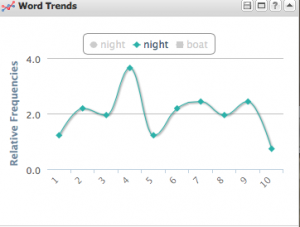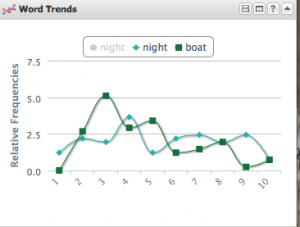Was James Merrill Linn accurate in his descriptions of his experience in the Battle of South Mills?
My research question was to find out if James Merrill Linn’s diary transcriptions were a legitimate primary source of information on the Battle of South Mills. To give background information to my audience, I started with my own diary entry date of April 17-18,

1862. I added these map notes to my new map of the Battle of South Mills. During this time, Linn left New Berne, stopped at Hatteras on Roanoke Island, and left for Elizabeth City. This is where I used transcriptions from Julia and Riz, who transcribed the actual battle. Using arcGIS, I mapped out exactly what Linn was writing to the best of my abilities. I used the color green to document anything Linn wrote in his diary to keep it separate for the next step in my research project. During this segment, I did not look at outside sources, besides a couple maps, in order to keep myself zoned in on Linn’s account of what was happening.

After mapping out Linn’s version of the Battle of South Mills, I searched for third-party sources that could give me more of an idea of what happened. Using objective sources allowed me to focus on the big picture of this battle and not just what Linn wrote in his diary. When utilizing these sources, I focused on the Pennsylvania 51st Regiment. This was Linn’s regiment, so I assume Linn was with these other soldiers. Gaining more knowledge about the Linn regiment’s whereabouts during this battle made allowed me to gain more insight to what Linn could have been talking about. Also, I wanted to contrast what Linn claimed in his diary to what these other sources claimed. I also mapped out the third-party’s account of the Battle of South Mills and the Pennsylvania 51st Regiment. When mapping this out on arcGIS, I used a new layer and used the color yellow to make all of the pushpins, lines, arrows, etc. This allowed me to see clearly both accounts of the Battle of South Mills.

When the Battle of South Mills was mapped out according to both perspectives, I created a web mapping application. Here, I chose the story template. At first I had a few slides to show the background information on the battle. Once I got to the actual battle, I switched between Linn’s claims and the third-party source’s claims. I utilized the zoom tool and tried to make this part of the project the most user-and-reader friendly. I added pictures of some of the maps that I found on my outside sources that really helped me visualize this battle. Because it happened over 150 years ago, there are not many official accounts of this battle. Technology was not exactly up to par. However, studying many hand-drawn maps of the Battle of South Mills allowed me to get a pretty good idea of how this battle played out.

I decided to narrow down my focus to just actions Linn and his regiment took. I did not want to complicate this research question by adding in emotions, causalities, etc. I took a very objective view while mapping out the Battle of South Mills. This made everything much cleaner and efficient when using the web map and later the web map app. Another “blessing” to me was a website Riz found on the internet called “Battle of South Mills.” It had an abundance of hand-drawn maps of the battle. Also, it was interesting to see some of the artifacts of the battle. Another person’s perspective I payed close attention to while mapping the third party sources’ version of the battle, was that of Lieutenant Colonel Bell. He referenced Linn’s Regiment, Pennsylvania 51st, many times. Whenever I saw something that mentioned Linn’s regiment I was payed extreme attention to it.

Ultimately, arcGIS was a great tool to use to map out the Battle of South Mills. I think it is very user-friendly and anyone would be able to use the web mapping application. I was able to take James Merrill Linn’s diary entries and compare them to third party sources to see his accuracy. At the end of this project, I was not able to completely decide if Linn is an accurate historical storyteller, because I only researched one battle. In my case, I think Linn was a somewhat reliable source. Besides for some minor contrasts in documentation of the battle, it is hard to tell which source was correct. I was only able to find one website that had other sources and account of the Battle of South Mills. I am not even sure how factual that website is. My research question could not sufficiently be answered with this one project.
Citations
“Battle Summary.” Battle of South Mills. Ed. Bruce Long. 10 Apr. 2010. Web. 14 Dec. 2014.
Civil War Cannon. Digital image. Mediad.publicbroadcasting. Web. 16 Dec. 2014. Linn. Digital image. Diane Jakacki. DianeJakacki.net. Web. 16 Dec. 2014.
Civil War Fence. Digital image. Big Stock. Web. 16 Dec. 2014.
Currituck Beach Lighthouse. Digital image. Currituck Beach Light. Web. 16 Dec. 2014.
Currituck Courthouse. Digital image. Appox. Web. 16 Dec. 2014.
Cypress Swamp Along Pasquotank River. Digital image. Champiii. 5 May 2014. Web. 16 Dec. 2014.
“Eastern Coast.” Eastern Portion of the Military Department of North Carolina. S.l. 1862. Print.
Hatteras Island. Digital image. Ocean Front Hotels. Web. 16 Dec. 2014.
Historic Old Jail in Currituck. Digital image. Albemarle Commission. Web. 16 Dec. 2014.
Mouth of Pasquotank River. Digital image. Api.ning. Web. 16 Dec. 2014.
Museum of the Albemarle. Digital image. Battle of South Mills. Bruce Long. Web. 16 Dec. 2014. Operations in North Carolina. Digital image. Battle of South Mills. Bruce Long. Web. 16 Dec. 2014.
Shenandoah 3. Digital image. Tom McMahon. Web. 16 Dec. 2014.
Sneden, Robert K. “Plan of Battle of South Mills.” 1862. ArcGIS. Web. 16 Dec.
2014.
“South Mills Battle.” ArcGIS. Web. 16 Dec. 2014.
The Battle of Camden. Digital image. Battle of South Mills. Bruce Long. Web. 16 Dec. 2014.
The Battle of Camden: Plan of the Battlefield. Digital image. Battle of South Mills. Bruce Long. Web. 16 Dec. 2014.





 The first world I selected was “night.” This word appears 82 times throughout the text. As I clicked on the word in cirrus tool and viewed it on the word trends tool, I did not notice any patterns whatsoever. Especially during the time period Dr. J. addresses, there was a consistent frequency of the number of times night was used. It also did not appear to be too much different than the beginning diary transcripts, either. Distant reading using this word alone, did not help with Professor Jackacki’s research question.
The first world I selected was “night.” This word appears 82 times throughout the text. As I clicked on the word in cirrus tool and viewed it on the word trends tool, I did not notice any patterns whatsoever. Especially during the time period Dr. J. addresses, there was a consistent frequency of the number of times night was used. It also did not appear to be too much different than the beginning diary transcripts, either. Distant reading using this word alone, did not help with Professor Jackacki’s research question. However, when I added a second word, “boat,” I noticed a distinct interesting. I noticed these two trends were almost mirror images of each other. There seemed to be a negative correlation between talking about night and talking about boats. Whenever Linn was talking about a boat, typically the Cossack, he did not seem to be mentioning night. This leads me to the question: when Linn is on board the Cossack, is he writing at night, therefore he does not mention night, or does all the action seem to talk place during daylight hours? Why does is there this strange relationship between “boat” and “night”?
However, when I added a second word, “boat,” I noticed a distinct interesting. I noticed these two trends were almost mirror images of each other. There seemed to be a negative correlation between talking about night and talking about boats. Whenever Linn was talking about a boat, typically the Cossack, he did not seem to be mentioning night. This leads me to the question: when Linn is on board the Cossack, is he writing at night, therefore he does not mention night, or does all the action seem to talk place during daylight hours? Why does is there this strange relationship between “boat” and “night”?